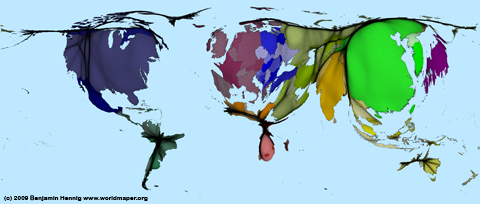Carbon dioxide emissions are gaining yet another boost of attention in the countdown to the Copenhagen climate change summit. We took that as an opportunity to update our worldmapper carbon emissions map with more recent figures. The most reliable figures are compiled in the UNStats MDG reports providing global data for 2006. Using this dataset, we calculated the new Carbon Emissions Map, resizing the territories according to the proportion of carbon dioxide emissions (note: see more maps here):

Furthermore, we did some calculations to show the real dimension of CO2 emissions by the population in each of the countries (or territories). We re-coloured the previous map with per capita greenhouse gas emissions. These give us an indication how the major polluters compare related to their population’s individual levels of emissions:

Finally, any agreements in Copenhagen will be compared to what the Kyoto protocol proposed some 17 years ago. This refers to the 1990 levels of CO2 emissions, which we put on a third map: Again, we took the per capita consumption as a base for the colours, rather than the change in total emissions. In this map we can see which countries have improved their carbon dioxide footprint on an indiviual level copared to the per capita emissions in 1990 and which have changed for the worse:

The content on this page has been created by Benjamin Hennig. Please contact me for further details on the terms of use.






